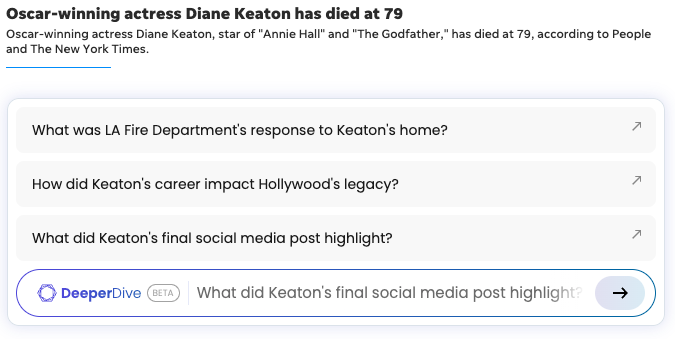The common discussion around AI search has been focused on the broader consumer shift from searching content on a platform like Google to instead seeking direct answers. It’s a philosophical distinction, but one that speaks directly to how everyday people are seeking information to support their lives.
But search is more than just finding answers from Google, Bing, AskJeeves (Mediaweek’s tongue is firmly in cheek on that one), ChatGPT, Claude, or Perplexity. AI Search has the capability of broadening the user experience across every type of website.
Mediaweek was especially impressed by the ‘Search AI’ integration into US news website USA Today. It uses DeeperDive AI, a platform built by the team at Taboola and can be used by readers to get deeper insights on news stories and to use the existing USA Today archive to drive deeper understanding of today’s news. It’s a great example of mining value out of work that previously had limited attention in a deep archive of data.

This search chatbot is found as a break-out box in the middle of a news story text, encouraging readers to read deeper
Similar value can be extracted from retail websites. The introduction of Search AI can benefit the customer experience directly through being able to find products that better match the experience they desire, or through other areas of the online retail experience like after-sales support. By better understanding meaning, context, and intent, Search AI has the capability to deliver more relevant, intuitive, and scalable experiences.
Elastic is an open-source Search AI platform working at scale to deliver instantly searchable results, AI driven relevance, and real‑time analysis. It bills itself as a solution to improve search, observability, and security. Mediaweek spoke with Jeremy Pell, AVP – ANZ at Elastic about what is possible from a retail perspective when it comes to Search AI.
There we go. Okay, so part of what I guess was sort of pitched at me to talk about was search, well, Search AI from a retail perspective. So we might just sort of talk about that first, but then also maybe just find a few ways to sort of talk a bit further about some of the possibilities in search, Search AI.
“It’s worth thinking about the market and where things are happening versus what we’re actually doing, because we’re just meeting the customer expectations now,” Pell said. “Even if you just look at your daily life and how things change, more than ever, everything’s starting with search now. And the introduction of the likes of the LLMs that have come through have only meant that customers want a better search experience.”

Jeremy Pell, AVP – ANZ at Elastic
Where Pell has noticed a change is in the level of expectation consumers have now while accessing retail sites. He reckons we are seeing the death of the keyword.
“Keywords just aren’t really cutting it. Customers want to have context… ‘try and think about what I want before it comes,'” he said. “That’s what Search AI is basically doing. It’s grabbing a deeper insight of the customers to be able to find the right product for that customer faster.
“Brand loyalty is somewhat dying, you know, you can go and buy it from any other site. If you don’t get that answer you want quickly, you’ll go to somewhere where you’re going to be able to get it from.”
Of course, greater information and context goes both ways. While customers are able to search sites with greater efficiencies to find the most-suitable products with less friction, online retail store owners can also use this greater context about audience interests to target them with specific products.
For example, customers on a shoe website may tell a chatbot that they want my pair of running shoes that are going to be good for wet weather and through the language used or the location of the customer, the system may identify that it is a high margin customer that might be willing to spend that little bit more.
Pell further identifies other retailer benefits: “It could also be things like when there’s a glut of stock, to be able to get stock off the shelf. Being able to do geolocation or better still, the positive thing, when you can exclude areas that isn’t in stock. Because how bad is that experience when you search for something, you finally go to the checkout, it says, ‘oh, we don’t have your size 11 sneakers’. But you’ve already got your heart on it. So it’s about putting those guardrails and pointing it in the right direction.”
Next month will see the Christmas sales season kick-off with Black Friday on 28 November, which then leads into Cyber Monday, and then the month-long online drive towards the pre-Christmas Australia Post cut-off date. Websites these days are pretty reliable in terms of their uptimes, but with Search AI being introduced into the online retail environment, could we see greater risk this year of sites failing to cope with the server load. After all, AI can be very compute-heavy.
Pell took this as an opportunity to talk about his platform Elastic and its track record with managing traffic at scale. He’s confident.
“We work with DocuSign – they’ve got 1 billion users that use our product across 180 countries, and that’s processing millions of agreements every single day from a whole bunch of different unstructured data, be it email, be it SharePoints, etc. So we’ve already got scale built into the platform.
“We don’t put the data on the customer-facing applications – we have the data sitting in the Elastic platform and query the data when we need it to send it to the customer-facing site. So there’s no additional load that goes to the customer-facing application.”
Beyond retail, there are an endless range of opportunities for using Search AI. In thinking about the Mediaweek audience, one use could be for radio industry professionals to consider radio ratings, which offer years of regular listener surveys. This extensive data could be overlayed with, for example, weather data to determine audience moods to see if that is impacting listening trends.
“Where I’m really excited about Search AI is, consider [your team’s] data scientist who’s probably overworked and you’ve got to raise a ticket to speak to them. Or they want to understand who the analytics are. Imagine a world where Search AI opens it up to everyone, not just the technical staff, being able to talk to her and ask: ‘What does the weather look like? When you look at weather overlaid with this rating, what does that look like?’ Or from a campaign perspective: ‘Can you optimise my performance in that campaign by 20% or what could I do?’ I’m really excited about where the LLMs are going to be able to make data available to everyone and what that means for brands to be able to get optimisations, but also increase performance as well.
The idea that Search AI is about the democratisation of access to data is something every professional working in a wider team can probably get behind.
